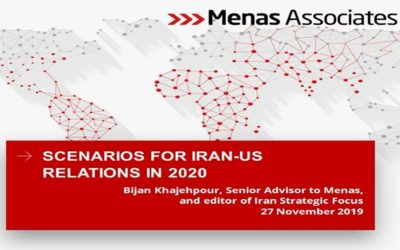Geopolitics, US Sanctions and Iran’s Oil Exports
12 Jun 2019 | Strategy & Risk

The 22 April announcement by the Trump administration that it won’t extend the sanctions waivers on the purchase of Iranian crude oil has created a new dynamics in the global oil market. Before assessing the impact of this decision, it should be underlined that the US is not imposing an “embargo”, but sanctions on services offered to facilitate the sale of Iranian crude and condensate. This means: Any foreign bank that continues to conduct transactions with Iran’s Central Bank (which controls accounts used to receive payments for Iranian oil exports) can be subject to exclusion from the US financial system.
Undeterred by US pressure: Oil export continues
Consequently, contrary to the stated US goal, this situation has not driven Iran’s oil exports to zero. In fact, there are numerous banks around the world, especially in the main Asian markets to which Iran exports oil, that do not have and do not seek a presence in the US financial system. As such, as long as there are refineries that opt to buy Iranian oil directly or indirectly (through traders), Iran will be able to export its petroleum products, though the volume of its exports will be reduced. Interestingly, against all expectations, in the first quarter of 2019, Iran managed to export an average daily volume of 1.5 million barrels of crude oil and condensate. The volume will certainly be lower in the second quarter of 2019.
Experts expect that Iran will manage to export some 700,000–800,000 bpd, partly because some of the state-owned refineries in China, India, and Turkey will refuse to submit to US pressure, and partly through indirect exports via Iraq or Russia.
Iran’s top-level response to the US decision came on 24 April 2019 by the country’s supreme leader, Ayatollah Ali Khamenei, who said that Iran would export as much as its own strategy has foreseen and it won’t be deterred by US pressure. The Iranian budget for the Iranian year, which started on 21 March 2019, is based on an export volume of 1.1 million barrels per day (bpd) and a barrel price of $60. Depending on the intensity of the enforcement of sanctions, it may become very challenging to achieve that level.
Geopolitical forces shift focus to the East
Experts expect that Iran will manage to export some 700,000–800,000 bpd, partly because some of the state-owned refineries in China, India, and Turkey will refuse to submit to US pressure, and partly through indirect exports via Iraq or Russia. Iraq has already stated that it would increase production by 250,000 bpd to make up for the Iranian loss, but that volume may actually be blended with oil from Iranian wells and be exported via Iraqi terminals.
There are other geopolitical forces at play. For example, whether Chinese refineries will cut their imports from Iran will also depend on the progress in China-US trade talks. On the other side, if Indian refineries stop buying Iranian oil, India would probably lose its access to the Chabahar port in south-eastern Iran through which it exports to Central Asia. As such, the final decision on the volumes of export will depend on a number of geopolitical factors.
An additional parameter that will influence the developments will be the availability of enough sources to replace Iran’s crude oil. With sanctions imposed on Venezuela and increasing uncertainty in Libya, the global market will be under pressure. The easing of the global oil price indicates that key market players do not see conditions in which Iran’s exports would fall to zero.
Washington’s “maximum pressure” campaign at work
In any case, the US decision has increased the financial headaches for the Iranian government. One question is whether the continued escalation of pressure by the Trump administration will lead to a wider conflict between Iran and the US. In fact, prior to the recent announcement, Washington had also designated the Islamic Revolutionary Guards Corps (IRGC) as a foreign terrorist organization (FTO), further irritating the Iranian political establishment.
There is little doubt that Washington’s so-called “maximum pressure” campaign is putting economic and psychological pressure on Iran. However, despite the posturing by Iranian hardliners, Tehran will continue to exercise its so-called “strategic patience” and wait until Trump is out of office. Statements such as a potential closure of the Strait of Hormoz are just public posturing for domestic audiences and not a serious plan in the decision-making circles in Iran.
Moderate forces in Iran continue to argue that Iran cannot gain anything from exiting the nuclear deal, also known as JCPOA, and that such a move would be a gift to the Trump administration that would then try to shift the confrontation to a new level. On the other side, it is also certain that Iran won’t back down and won’t offer any concessions to the US.
In the meantime, mediation efforts by regional and international players are gaining momentum and it remains to be seen whether the de-escalation efforts will be successful.
Fact is that the Iran-US dynamics remains complex and it is fully interdependent on many other factors including geopolitical developments, regional realities – especially the situations in Iraq, Afghanistan and Syria – as well as oil market developments. A continuous analysis of all these factors can help us in predicting the course of events, especially the risks to international business.
Related Services
Strategy & Risk
To capitalize on new opportunities, a strong strategy needs to keep pace with rapid change while navigating risk with foresight and confidence.

Dr. Bijan Khajehpour | Managing Partner
Bijan is a veteran strategy advisor for the West Asian markets and has over 25 years of strategic consulting experience with global companies. Read more

Bijan is a veteran strategy advisor for the West Asian markets and has over 25 years of strategic consulting experience with global companies. Read more
Recent Posts
The Latest Geopolitical Developments in Eurasia
What geopolitical shifts are happening from China to West Asia and Europe? And what future opportunities exist in Eurasia?
Podcast: Scenarios for Iran-US Relations in 2020
Following an analysis of recent Iran-US relations, possible scenarios and signposts for 2020 are discussed.
What could be the hidden risks of entering a new market?
And what are three main steps that can address these hidden risks?



